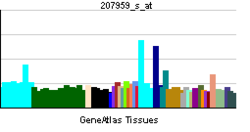- DNAH9
-
Dynein, axonemal, heavy chain 9 Identifiers Symbols DNAH9; DNAH17L; DNEL1; DYH9; Dnahc9; HL-20; HL20; KIAA0357 External IDs OMIM: 603330 MGI: 1289279 HomoloGene: 20357 GeneCards: DNAH9 Gene Gene Ontology Molecular function • nucleotide binding
• motor activity
• microtubule motor activity
• ATP binding
• ATPase activityCellular component • cytoplasm
• cytoskeleton
• axonemal dynein complex
• microtubule
• cilium
• cilium axonemeBiological process • cellular component movement
• microtubule-based movement
• spermatogenesis
• cell projection organizationSources: Amigo / QuickGO RNA expression pattern 

More reference expression data Orthologs Species Human Mouse Entrez 1770 237806 Ensembl ENSG00000007174 ENSMUSG00000056752 UniProt Q9NYC9 n/a RefSeq (mRNA) NM_001372.3 NM_001099633.1 RefSeq (protein) NP_001363.2 NP_001093103.1 Location (UCSC) Chr 17:
11.5 – 11.87 MbChr 11:
65.64 – 65.98 MbPubMed search [1] [2] Dynein heavy chain 9, axonemal is a protein that in humans is encoded by the DNAH9 gene.[1][2][3]
This gene encodes the heavy chain subunit of axonemal dynein, a large multi-subunit molecular motor. Axonemal dynein attaches to microtubules and hydrolyzes ATP to mediate the movement of cilia and flagella. The gene expresses at least two transcript variants; additional variants have been described, but their full length nature has not been determined.[3]
References
- ^ Vaughan KT, Mikami A, Paschal BM, Holzbaur EL, Hughes SM, Echeverri CJ, Moore KJ, Gilbert DJ, Copeland NG, Jenkins NA, Vallee RB (Feb 1997). "Multiple mouse chromosomal loci for dynein-based motility". Genomics 36 (1): 29–38. doi:10.1006/geno.1996.0422. PMID 8812413.
- ^ Bartoloni L, Blouin JL, Maiti AK, Sainsbury A, Rossier C, Gehrig C, She JX, Marron MP, Lander ES, Meeks M, Chung E, Armengot M, Jorissen M, Scott HS, Delozier-Blanchet CD, Gardiner RM, Antonarakis SE (Mar 2001). "Axonemal beta heavy chain dynein DNAH9: cDNA sequence, genomic structure, and investigation of its role in primary ciliary dyskinesia". Genomics 72 (1): 21–33. doi:10.1006/geno.2000.6462. PMID 11247663.
- ^ a b "Entrez Gene: DNAH9 dynein, axonemal, heavy chain 9". http://www.ncbi.nlm.nih.gov/sites/entrez?Db=gene&Cmd=ShowDetailView&TermToSearch=1770.
Further reading
- Milisav I, Jones MH, Affara NA (1996). "Characterization of a novel human dynein-related gene that is specifically expressed in testis". Mamm. Genome 7 (9): 667–72. doi:10.1007/s003359900202. PMID 8703119.
- Nagase T; Ishikawa K; Nakajima D et al. (1997). "Prediction of the coding sequences of unidentified human genes. VII. The complete sequences of 100 new cDNA clones from brain which can code for large proteins in vitro". DNA Res. 4 (2): 141–50. doi:10.1093/dnares/4.2.141. PMID 9205841.
- Bartoloni L; Blouin J; Sainsbury AJ et al. (1999). "Assignment of the human dynein heavy chain gene DNAH17L to human chromosome 17p12 by in situ hybridization and radiation hybrid mapping". Cytogenet. Cell Genet. 84 (3–4): 188–9. doi:10.1159/000015254. PMID 10393427.
- Reed W; Carson JL; Moats-Staats BM et al. (2001). "Characterization of an axonemal dynein heavy chain expressed early in airway epithelial ciliogenesis". Am. J. Respir. Cell Mol. Biol. 23 (6): 734–41. PMID 11104725.
- Maiti AK; Mattéi MG; Jorissen M et al. (2001). "Identification, tissue specific expression, and chromosomal localisation of several human dynein heavy chain genes". Eur. J. Hum. Genet. 8 (12): 923–32. doi:10.1038/sj.ejhg.5200555. PMID 11175280.
- Carson JL; Reed W; Lucier T et al. (2002). "Axonemal dynein expression in human fetal tracheal epithelium". Am. J. Physiol. Lung Cell Mol. Physiol. 282 (3): L421–30. doi:10.1152/ajplung.00147.2001. PMID 11839535.
- Strausberg RL; Feingold EA; Grouse LH et al. (2003). "Generation and initial analysis of more than 15,000 full-length human and mouse cDNA sequences". Proc. Natl. Acad. Sci. U.S.A. 99 (26): 16899–903. doi:10.1073/pnas.242603899. PMC 139241. PMID 12477932. http://www.pubmedcentral.nih.gov/articlerender.fcgi?tool=pmcentrez&artid=139241.
- Ota T; Suzuki Y; Nishikawa T et al. (2004). "Complete sequencing and characterization of 21,243 full-length human cDNAs". Nat. Genet. 36 (1): 40–5. doi:10.1038/ng1285. PMID 14702039.
- Horváth J; Fliegauf M; Olbrich H et al. (2005). "Identification and analysis of axonemal dynein light chain 1 in primary ciliary dyskinesia patients". Am. J. Respir. Cell Mol. Biol. 33 (1): 41–7. doi:10.1165/rcmb.2004-0335OC. PMID 15845866.
Categories:- Human proteins
- Chromosome 17 gene stubs
Wikimedia Foundation. 2010.
